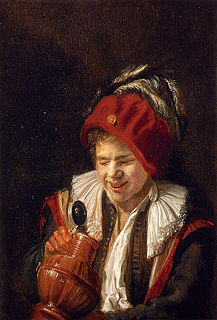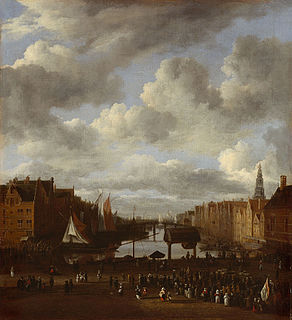
Gabriël Metsu (1629–1667) was a Dutch painter of history paintings, still lifes, portraits, and genre works. He was "a highly eclectic artist, who did not adhere to a consistent style, technique, or one type of subject for long periods". Only 14 of his 133 works are dated.

Judith Jans Leyster was a Dutch Golden Age painter. She painted genre works, portraits and still lifes. Although her work was highly regarded by her contemporaries, Leyster and her work became almost forgotten after her death. Her entire oeuvre was attributed to Frans Hals or to her husband, Jan Miense Molenaer, until 1893.

Dutch Golden Age painting is the painting of the Dutch Golden Age, a period in Dutch history roughly spanning the 17th century, during and after the later part of the Eighty Years' War (1568–1648) for Dutch independence.

Woman Holding a Balance, also called Woman Testing a Balance, is an oil painting by Dutch Golden Age painter Johannes Vermeer, now in the National Gallery of Art in Washington, DC.

Le Pont de l'Europe is an oil painting by French impressionist Gustave Caillebotte completed in 1876. It is held by the Musée du Petit Palais in Geneva, Switzerland. The finished canvas measures 125 by 181 centimetres.

The Fingernail Test is a painting by the Dutch Golden Age painter Frans Hals or Judith Leyster, painted in 1626 and now in the Metropolitan Museum of Art, New York City.

Self-portrait by Judith Leyster is an Dutch Golden Age painting in oils in the collection of the National Gallery of Art that was offered in 1633 as a masterpiece to the Haarlem Guild of St. Luke. It was attributed for centuries to Frans Hals and was only properly attributed to Judith Leyster upon acquisition by the museum in 1949. The style is indeed comparable to that of Hals, Haarlem's most famous portraitist.

The Jolly Toper is a 1629 oil painting by Judith Leyster in the collection of the Rijksmuseum that is on long term loan to the Frans Hals Museum since 1959. It was acquired by the museum as a painting by Frans Hals and was attributed to Leyster by the researcher Juliane Harms in 1927.

The Serenade is a 1629 oil painting by Judith Leyster in the collection of the Rijksmuseum. It was attributed for centuries to Frans Hals until Wilhelm von Bode saw it in the Six collection in 1883. He noticed the prominent "J" in the signature, and attributed it to Jan Hals. This is one of seven paintings first properly attributed to Leyster by Hofstede de Groot ten years later in 1893.

The Merry Trio is an oil painting by Judith Leyster in a private collection. It was considered a work by Frans Hals until 1903.

The Last Drop is a c. 1639 oil painting by Judith Leyster in the John G. Johnson collection of the Philadelphia Museum of Art. It was considered a work of art by Frans Hals until 1903, when it was noticed that it is signed 'JL*' on the tankard.

A Youth with a Jug is a 1633 oil painting by Judith Leyster currently in a private collection.

Standing Cavalier is a painting by Judith Leyster in the Royal Collection. It is the only painting by Leyster with a provenance that reaches back to the 18th-century.

Young man playing the lute is an oil painting by Judith Leyster in the collection of the Rijksmuseum, and is a period copy of the same subject by Frans Hals. It was acquired by the museum as a painting by Frans Hals and was skipped by the researcher Juliane Harms in 1927, being finally attributed to Leyster by Seymour Slive in 1974.
In feminist theory, the male gaze is the act of depicting women and the world, in the visual arts and in literature, from a masculine, heterosexual perspective that presents and represents women as sexual objects for the pleasure of the male viewer. In the visual and aesthetic presentations of narrative cinema, the male gaze has three perspectives: (i) that of the man behind the camera, (ii) that of the male characters within the film's cinematic representations; and (iii) that of the spectator gazing at the image.

View of the Dam and Damrak at Amsterdam is a 17th-century oil on canvas painting by the Dutch Golden Age painter Jacob van Ruisdael. It is in the collection of the Mauritshuis in the Hague. It gives a bird's eye view of the crowd watching the parade of the civic guard on the Dam Square, the main square of Amsterdam.

A Boy and a Girl with a Cat and an Eel is a 1635 oil painting by Judith Leyster that is now in the National Gallery, London.

A Game of Tric-Trac is a painting by Judith Leyster from 1630.

Unequal Love is a circa 1631 painting, by the Dutch Golden Age painter Judith Leyster. It is in the collection of the Galleria Nazionale d'Arte Antica, Rome.



















